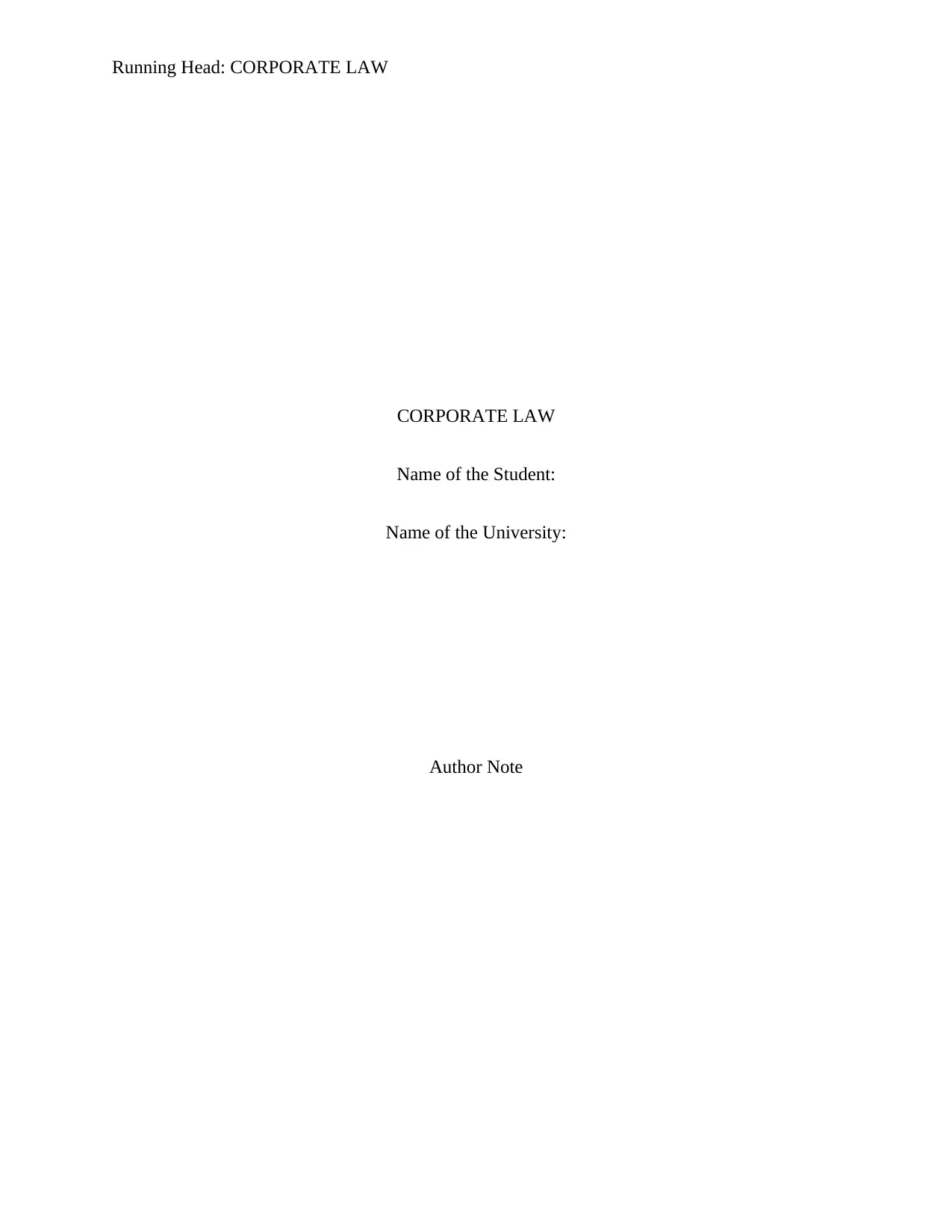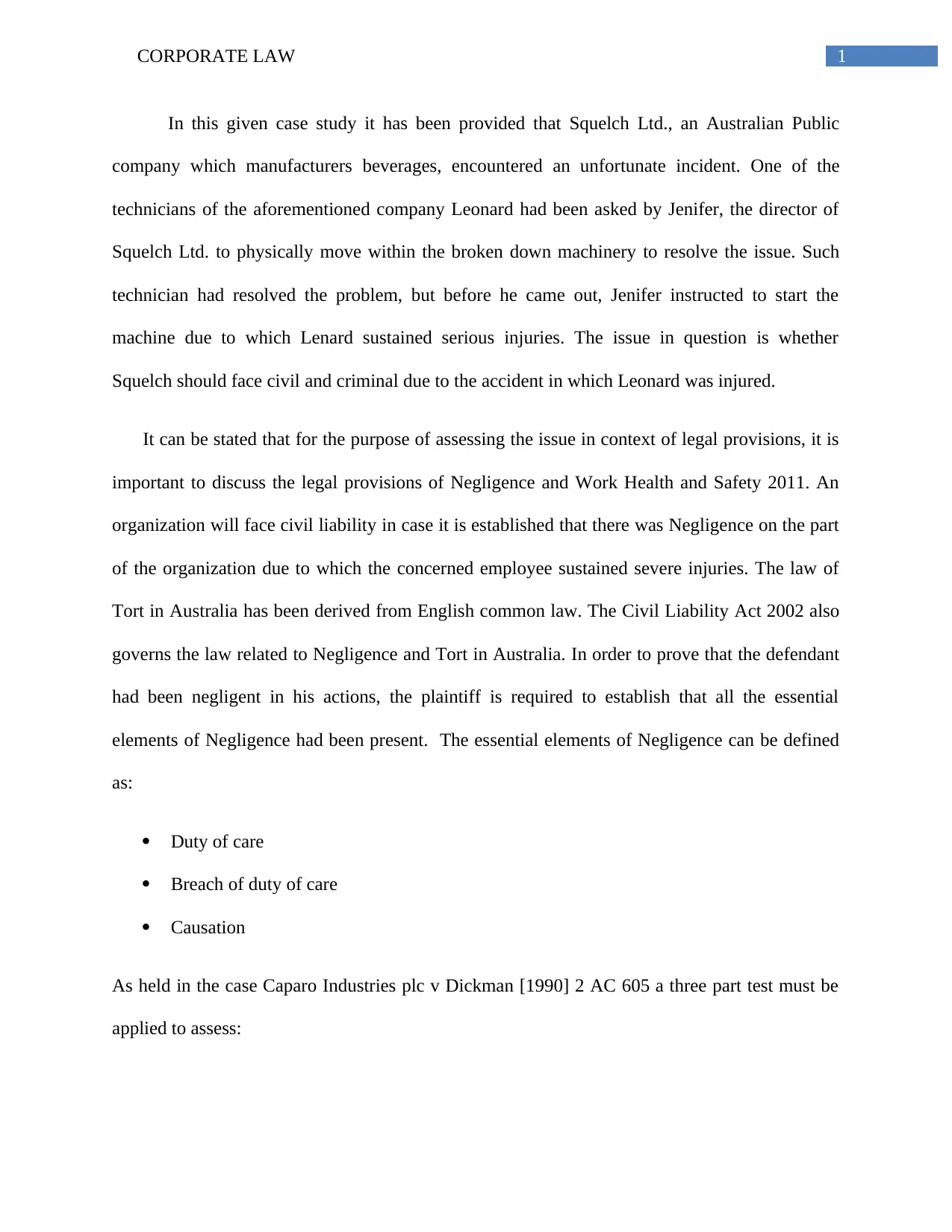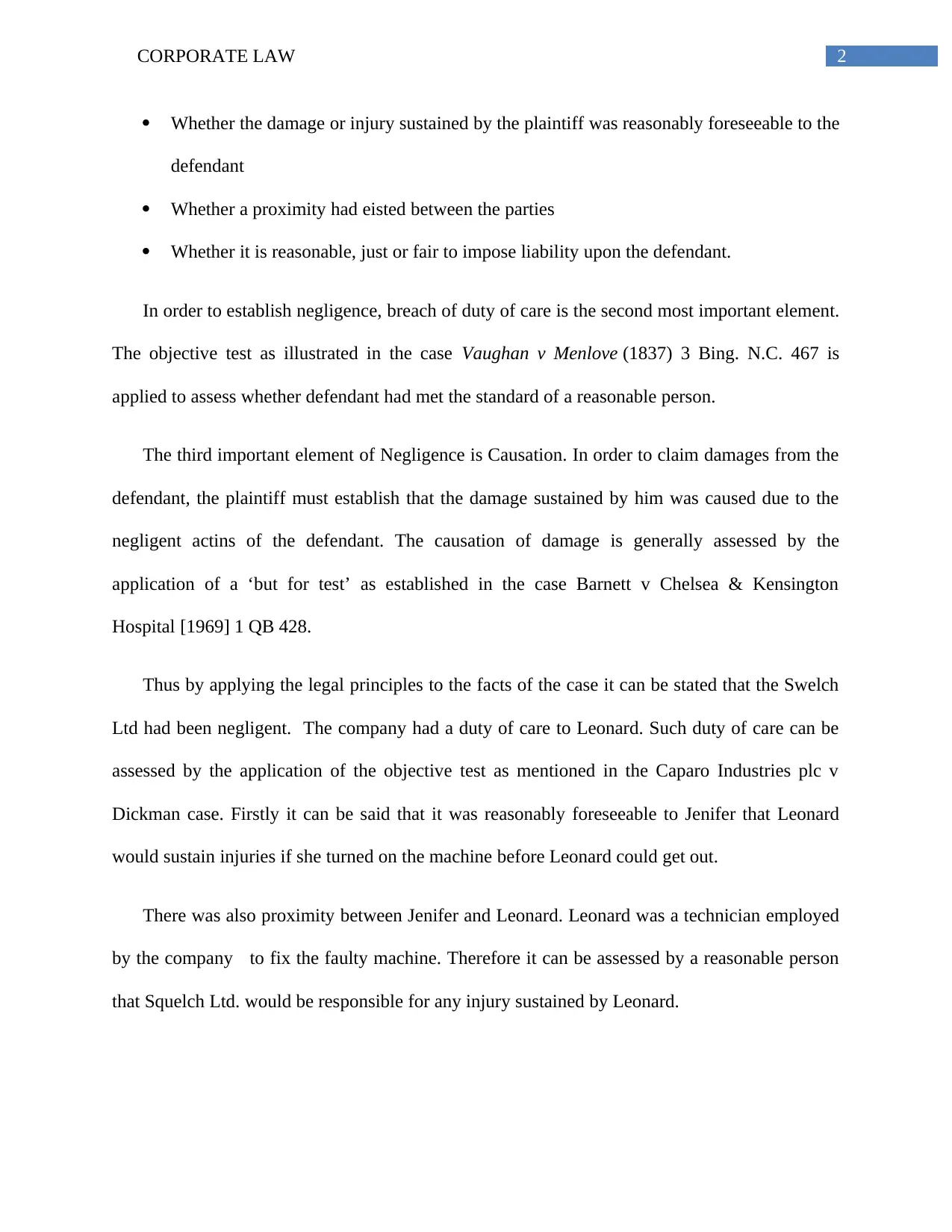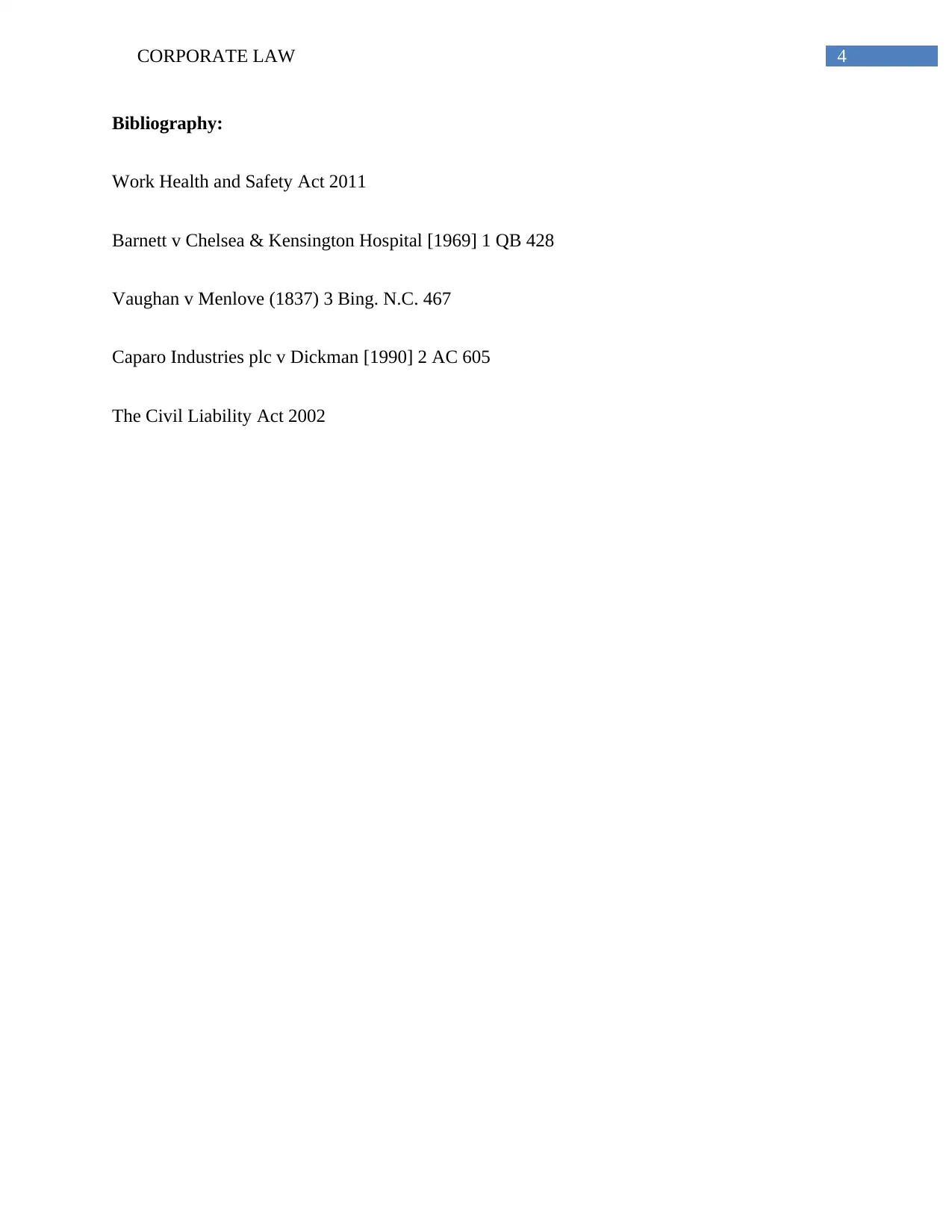LEGL101 Case Study: Assessing Squelch Ltd's Civil & Criminal Liability
VerifiedAdded on 2023/06/14
|5
|914
|419
Case Study
AI Summary
This case study examines the potential civil and criminal liabilities of Squelch Ltd., an Australian public company, following an incident where a technician, Leonard, sustained serious injuries due to the negligence of a director, Jenifer. The analysis focuses on establishing negligence based on duty of care, breach of duty, and causation, referencing relevant case law such as Caparo Industries plc v Dickman and Barnett v Chelsea & Kensington Hospital. The study also considers the implications of the Work Health and Safety Act 2011, highlighting potential criminal liability for non-compliance leading to employee injury. Ultimately, the case study concludes that Squelch Ltd. is likely liable for negligence and faces potential criminal charges, entitling Leonard to claim damages. Desklib provides access to similar case studies and solved assignments for students.

Running Head: CORPORATE LAW
CORPORATE LAW
Name of the Student:
Name of the University:
Author Note
CORPORATE LAW
Name of the Student:
Name of the University:
Author Note
Paraphrase This Document
Need a fresh take? Get an instant paraphrase of this document with our AI Paraphraser

1CORPORATE LAW
In this given case study it has been provided that Squelch Ltd., an Australian Public
company which manufacturers beverages, encountered an unfortunate incident. One of the
technicians of the aforementioned company Leonard had been asked by Jenifer, the director of
Squelch Ltd. to physically move within the broken down machinery to resolve the issue. Such
technician had resolved the problem, but before he came out, Jenifer instructed to start the
machine due to which Lenard sustained serious injuries. The issue in question is whether
Squelch should face civil and criminal due to the accident in which Leonard was injured.
It can be stated that for the purpose of assessing the issue in context of legal provisions, it is
important to discuss the legal provisions of Negligence and Work Health and Safety 2011. An
organization will face civil liability in case it is established that there was Negligence on the part
of the organization due to which the concerned employee sustained severe injuries. The law of
Tort in Australia has been derived from English common law. The Civil Liability Act 2002 also
governs the law related to Negligence and Tort in Australia. In order to prove that the defendant
had been negligent in his actions, the plaintiff is required to establish that all the essential
elements of Negligence had been present. The essential elements of Negligence can be defined
as:
Duty of care
Breach of duty of care
Causation
As held in the case Caparo Industries plc v Dickman [1990] 2 AC 605 a three part test must be
applied to assess:
In this given case study it has been provided that Squelch Ltd., an Australian Public
company which manufacturers beverages, encountered an unfortunate incident. One of the
technicians of the aforementioned company Leonard had been asked by Jenifer, the director of
Squelch Ltd. to physically move within the broken down machinery to resolve the issue. Such
technician had resolved the problem, but before he came out, Jenifer instructed to start the
machine due to which Lenard sustained serious injuries. The issue in question is whether
Squelch should face civil and criminal due to the accident in which Leonard was injured.
It can be stated that for the purpose of assessing the issue in context of legal provisions, it is
important to discuss the legal provisions of Negligence and Work Health and Safety 2011. An
organization will face civil liability in case it is established that there was Negligence on the part
of the organization due to which the concerned employee sustained severe injuries. The law of
Tort in Australia has been derived from English common law. The Civil Liability Act 2002 also
governs the law related to Negligence and Tort in Australia. In order to prove that the defendant
had been negligent in his actions, the plaintiff is required to establish that all the essential
elements of Negligence had been present. The essential elements of Negligence can be defined
as:
Duty of care
Breach of duty of care
Causation
As held in the case Caparo Industries plc v Dickman [1990] 2 AC 605 a three part test must be
applied to assess:

2CORPORATE LAW
Whether the damage or injury sustained by the plaintiff was reasonably foreseeable to the
defendant
Whether a proximity had eisted between the parties
Whether it is reasonable, just or fair to impose liability upon the defendant.
In order to establish negligence, breach of duty of care is the second most important element.
The objective test as illustrated in the case Vaughan v Menlove (1837) 3 Bing. N.C. 467 is
applied to assess whether defendant had met the standard of a reasonable person.
The third important element of Negligence is Causation. In order to claim damages from the
defendant, the plaintiff must establish that the damage sustained by him was caused due to the
negligent actins of the defendant. The causation of damage is generally assessed by the
application of a ‘but for test’ as established in the case Barnett v Chelsea & Kensington
Hospital [1969] 1 QB 428.
Thus by applying the legal principles to the facts of the case it can be stated that the Swelch
Ltd had been negligent. The company had a duty of care to Leonard. Such duty of care can be
assessed by the application of the objective test as mentioned in the Caparo Industries plc v
Dickman case. Firstly it can be said that it was reasonably foreseeable to Jenifer that Leonard
would sustain injuries if she turned on the machine before Leonard could get out.
There was also proximity between Jenifer and Leonard. Leonard was a technician employed
by the company to fix the faulty machine. Therefore it can be assessed by a reasonable person
that Squelch Ltd. would be responsible for any injury sustained by Leonard.
Whether the damage or injury sustained by the plaintiff was reasonably foreseeable to the
defendant
Whether a proximity had eisted between the parties
Whether it is reasonable, just or fair to impose liability upon the defendant.
In order to establish negligence, breach of duty of care is the second most important element.
The objective test as illustrated in the case Vaughan v Menlove (1837) 3 Bing. N.C. 467 is
applied to assess whether defendant had met the standard of a reasonable person.
The third important element of Negligence is Causation. In order to claim damages from the
defendant, the plaintiff must establish that the damage sustained by him was caused due to the
negligent actins of the defendant. The causation of damage is generally assessed by the
application of a ‘but for test’ as established in the case Barnett v Chelsea & Kensington
Hospital [1969] 1 QB 428.
Thus by applying the legal principles to the facts of the case it can be stated that the Swelch
Ltd had been negligent. The company had a duty of care to Leonard. Such duty of care can be
assessed by the application of the objective test as mentioned in the Caparo Industries plc v
Dickman case. Firstly it can be said that it was reasonably foreseeable to Jenifer that Leonard
would sustain injuries if she turned on the machine before Leonard could get out.
There was also proximity between Jenifer and Leonard. Leonard was a technician employed
by the company to fix the faulty machine. Therefore it can be assessed by a reasonable person
that Squelch Ltd. would be responsible for any injury sustained by Leonard.
⊘ This is a preview!⊘
Do you want full access?
Subscribe today to unlock all pages.

Trusted by 1+ million students worldwide

3CORPORATE LAW
Thirdly it can be stated that it would be reasonable and only fair to impose the liability on
Squelch of any harm likely to be caused to Leonard. Thus in this case a duty of care of Squelch
Ltd towards Leonard ca n be said to be existing.
Squelch Ltd. breached such duty of care. This can be substantiated by the application of the
test as provided in the case Vaughan v Menlove. Any reasonable person in this situation would
have waited till Leonard got out of the broken machiner which he was repairing.
The damage sustained by Leonard, can be said to be a direct cause of the breach of duty of
care by Squelch Ltd. This can be substated by the ‘But For’ test. It can be stated that Leonard
would not have sustained the injuries but for the omission of the negligent action of Squelch Ltd.
Thus in this case negligence of the part of Squelch has been established and Leonard is
entitled to claim damages for the injury sustained by him.
Further it can be stated that the Work health and Safety act 2011 provides that employers can
face criminal liability if they do not comply with the provisions of the aforementioned act. They
will face a greater liability if such non compliance results in the death and injury of the
concerned employee. Thus in this case Squelch Ltd will face criminal liability.
Thirdly it can be stated that it would be reasonable and only fair to impose the liability on
Squelch of any harm likely to be caused to Leonard. Thus in this case a duty of care of Squelch
Ltd towards Leonard ca n be said to be existing.
Squelch Ltd. breached such duty of care. This can be substantiated by the application of the
test as provided in the case Vaughan v Menlove. Any reasonable person in this situation would
have waited till Leonard got out of the broken machiner which he was repairing.
The damage sustained by Leonard, can be said to be a direct cause of the breach of duty of
care by Squelch Ltd. This can be substated by the ‘But For’ test. It can be stated that Leonard
would not have sustained the injuries but for the omission of the negligent action of Squelch Ltd.
Thus in this case negligence of the part of Squelch has been established and Leonard is
entitled to claim damages for the injury sustained by him.
Further it can be stated that the Work health and Safety act 2011 provides that employers can
face criminal liability if they do not comply with the provisions of the aforementioned act. They
will face a greater liability if such non compliance results in the death and injury of the
concerned employee. Thus in this case Squelch Ltd will face criminal liability.
Paraphrase This Document
Need a fresh take? Get an instant paraphrase of this document with our AI Paraphraser

4CORPORATE LAW
Bibliography:
Work Health and Safety Act 2011
Barnett v Chelsea & Kensington Hospital [1969] 1 QB 428
Vaughan v Menlove (1837) 3 Bing. N.C. 467
Caparo Industries plc v Dickman [1990] 2 AC 605
The Civil Liability Act 2002
Bibliography:
Work Health and Safety Act 2011
Barnett v Chelsea & Kensington Hospital [1969] 1 QB 428
Vaughan v Menlove (1837) 3 Bing. N.C. 467
Caparo Industries plc v Dickman [1990] 2 AC 605
The Civil Liability Act 2002
1 out of 5
Related Documents
Your All-in-One AI-Powered Toolkit for Academic Success.
+13062052269
info@desklib.com
Available 24*7 on WhatsApp / Email
![[object Object]](/_next/static/media/star-bottom.7253800d.svg)
Unlock your academic potential
Copyright © 2020–2025 A2Z Services. All Rights Reserved. Developed and managed by ZUCOL.





